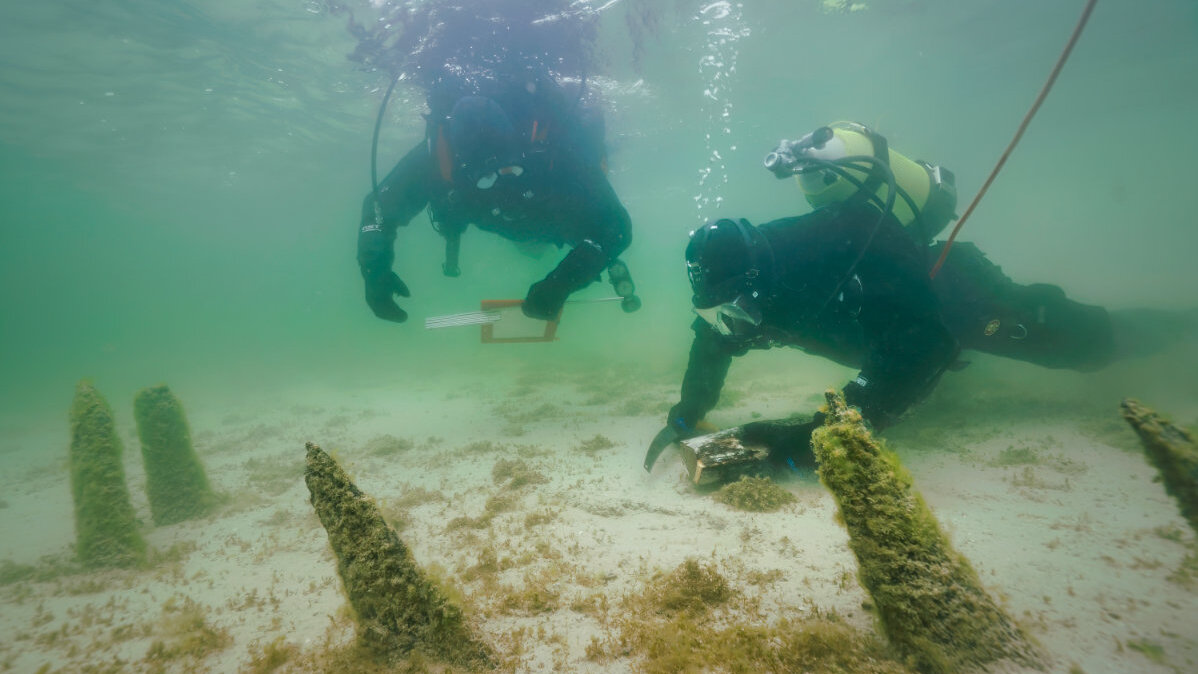At the end of this year’s research campaign, the LAD presented the first research results today (March 1) at a press event in Reichenau-Mittelzell. Representatives of the LAD and an employee of the company responsible for diving archeology, »UwArc«, were present.
“The longest of the three rows of piles stretches over 600 meters between St. Georg and Schopflen,” explained state archaeologist Prof. Dr. Dirk Krause. Another 500 meter long row lies in front of the bay at the Bauernhorn west of Mittelzell. A shorter piling also extends in front of Niederzell, Krausse continues. As part of the archaeological diving investigations, the commissioned company UwArc measured 1,300 piles, with some of them being sedimented and therefore not visible. The total stock can be estimated at around 2,500 pieces. “The trunks or clefts were sharpened with metal axes and are mostly made of oak,” added Dr. Bertram Jenisch from the Department of Medieval and Modern Archeology at the LAD.
dr Oliver Nelle from the Hemmenhofen Dendrochronological Laboratory of the LAD has already been able to determine the uniform felling date of 909 AD for several trees. According to the assessment of Dr. Bertram Jenisch in the tenure of Hatto III, one of the most dazzling abbots of Reichenau. Hatto (* around 850; † May 15, 913) was from 888 to 913 abbot of the monastery of Reichenau and other imperial monasteries as well as archbishop of Mainz. He was Chancellor of several German kings and thus one of the most powerful men at the transition from the 9th to the 10th century. During his time as abbot, the new building of the Minster and St. George’s in Oberzell fell.
The archaeologists suspect that the rows of poles were laid out on the north bank of the Reichenau in the heyday of the island monastery to direct shipping traffic. dr Julia Goldhammer, consultant for wet soil archeology at the LAD, said: »The present finding confirms that the archaeological consideration of landscapes must not end at the banks of water. Exciting structures that are connected to findings on land are often hidden under water.«
Reichenau Island has been a UNESCO World Heritage Site since 2000. So far, the protected area covers the area of the island up to the shore zone.
The Minister responsible for regional development and housing in Baden-Württemberg, Nicole Razavi MdL, announced on the occasion of the appointment: “The investigations of the shallow water zone open a new chapter in the exploration of the World Heritage site of the island of Reichenau. You can be curious about the results!«
Susanne Bay, District President of the Stuttgart Regional Council, was equally impressed at the on-site appointment: »The first test results make it clear how extensive the spatial planning around the monastery was already in the Middle Ages. The underwater project of the State Office for the Preservation of Monuments shows once again the importance of archaeological monument preservation for the research and preservation of our cultural heritage.«
In the coming weeks and months, archaeologists will continue to evaluate the results. Further dives are initially not planned.
The results of the investigations will be presented to the public in 2024 as part of the large state exhibition on Reichenau by the Baden State Museum in the rooms of the Archaeological State Museum in Konstanz. The LAD is a cooperation partner here.
